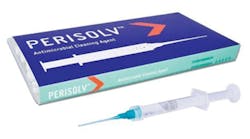Perisolv: A new way to treat perio using bleach
Bleach (sodium hypochlorite) has been used to treat periodontal disease before. But before you think of patients rinsing with diluted Clorox, check out this antimicrobial treatment option.
Treating periodontal disease with sodium hypochlorite (household bleach) is not a new concept. In fact, a small pilot study showed that a twice-weekly oral rinse with 0.25% sodium hypochlorite lowered dental plaque biofilm levels and bleeding on probing. (1) The study authors mentioned that long-term studies are needed. (1) This article will review a new product containing hypochlorite and amino acids.
Perisolv is a product of Carisolv from Sweden. It is a gel that is applied directly to the periodontal pocket where it dissolves degenerated tissue and has a bacteriostatic effect, which makes it easier to clean by scaling. According to the website, the active ingredients in Perisolv are low doses hypochlorite and amino acids. It is apparently painless with no side effects.
READ MORE | Dental news you can use: Bleach as mouthwash, biofilms, and more
Perisolv gel is a mixture of the amino acids glutamic acid, leucine, and lysine, combined with sodium chloride, carboxymethylcellulose, titanium dioxide, water, and sodium hydroxide. It has a pH of 11. The 0.95% sodium hypochlorite solution is a transparent liquid. (2) Unopened packages should be placed in a refrigerator, and the shelf life is 18 months from the date the product was manufactured. (2) Before use, bring the product to room temperature. Instructions for use are on the website. After the gel is mixed it loses efficacy in 30 minutes. You can view the application technique here.
READ MORE | An update on bleach swishing: Reviewing the literature on diluted bleach rinsing
There is limited research on the product, and one study is described on the on the website. There are other studies referenced from the medical and dental literature. (3) One study’s goal was to assess the antimicrobial activity of a sodium hypochlorite preparation (NaOCl gel) on bacteria associated with periodontal disease against 0.1 % chlorhexidine digluconate (CHX) solution. (4) The minimum inhibitory concentrations (MICs) of the NaOCl gel were equal as of the CHX solution against Gram-negatives but higher against Gram-positive bacteria. CHX but not NaOCl gel visibly inhibited biofilm formation, and NaOCl killed bacteria in the biofilm and affected with the matrix. (4) More study is needed to view these preparations as possible alternatives for adjunctive treatment in periodontitis.
References
1. Galván M, Gonzalez S, Cohen CL, et al. Periodontal effects of 0.25% sodium hypochlorite twice-weekly oral rinse. A pilot study. Journal of Periodontal Research, Volume 49, Issue 6, pages 696–702, December 2014.
2. http://perisolv.com/en.
3. http://perisolv.com/en/research.
4. Jurczyk K, Nietzsche S, Ender C, et al. In-vitro activity of sodium-hypochlorite gel on bacteria associated with periodontitis. Clinical Oral Investigations, pp 1-9, First online: 12 January 2016.
